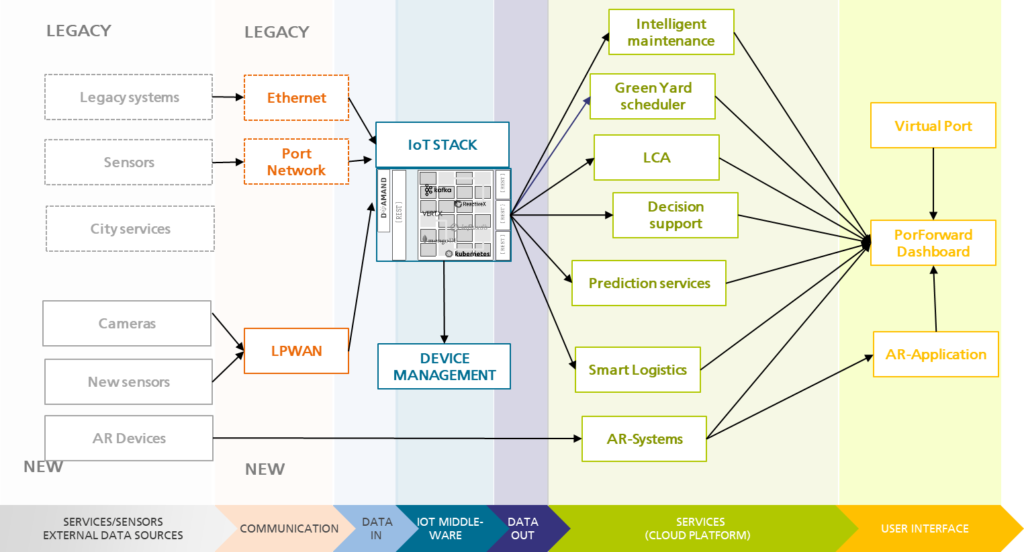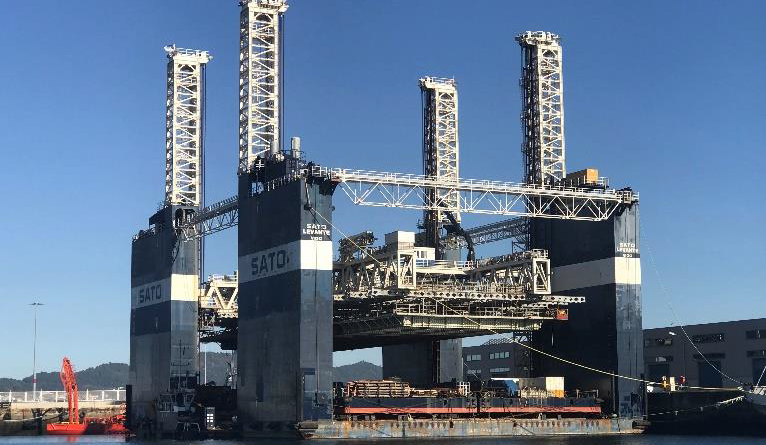PortForward Framework Design: generic, scalable and replicable architecture
After one year and a half of execution, the PortForward project finalised the work package 2, which designed the framework of the global system architecture for the PortForward platform. The challenge is to become the bridge between the specifications of the system and the technological development and use cases. Building on the existing systems of the port, the PortForward platform needs to be general and generic that can be applicable and scalable to most ports. The general aim is to improve the performance and the quality of the port processes and services improving the cost-benefit ratio. More specifically, the project has three objectives: (1) employ ICT solutions to improve information flows between ports and port communities, (2) adopt green technologies to reduce the environmental impacts of port operations and save resources, and (3) combine different modes of transport and integrating different technologies to better monitor and control freight flows.
With these objectives in mind, Leitat, as the leader of services architecture, and with the collaboration of the consortium experts and the different stakeholders involved, designed and set the basis to transform how stakeholders in the port ecosystem interact using digital tools and solutions, to enhance the logistic of the port operations.
The integration of different smart systems, devices and services, with decision support capabilities, are needed in order to comply with the objectives and ambitions of the project. Concretely, PortForward has identified three main pillars to be improved through the adoption of these new technologies making the port Smart, Interconnected and Green.
- Smart Port: Through the usage of novel information and communication technology solutions and smart devices, the port of the future will be able to:
- Enhance the operations and reliability of the yards through the monitoring of critical infrastructure, which will reduce or even avoid accidents and increase the cost-effectiveness of maintenance.
- Improve the efficiency of localisation processes of assets, using indoor/outdoor positioning technologies and reduce the energy consumption.
- Support the decisions of the operators by fusing heterogeneous data sources and decision support systems.
- Interconnected: The port of the future will include different technologies, such as long-range communication standards with the objective of achieving a better monitoring performance and improve the resilience of the network. This interconnectivity allows to aggregate more devices and consequently data to the control centre. This again can directly be translated into better decision making and a better knowledge of the environment. This increases the value of the data monitored, which nourishes the different services and makes the port smarter. In the PortForward framework, the interconnectivity pillar is covered through the implementation of low-power and long-range communication protocols and the ingestion of the sensing data through a highly customizable IoT middleware.
- Green: Following the European Commission 7th Environment Action Programme (7th EAP), the port of the future must be sustainable and resource-efficient. To support this, the port will be continuously monitored, and the operations will be scheduled from an environmental point of view. To meet the 7th EAP objectives, smart systems play a crucial role, allowing the automation of tasks like monitoring. Using the information collected, the services developed can support the decisions of the operators, considering the environmental ecosystem of the port. The environmental pillar is a core topic addressed by the project through different services in different scopes of the port. Some of the services that address this pillar are the LCA system, the green yard scheduler and the smart logistic tools.
The PortForward framework considers seven layers in the general architecture of the port as can be seen in the figure below. These layers can be grouped in tiers, a sensors and data tier, communication tier, covering from communication until data out and service tier, covering the cloud services and the user interface.

On the left part of the figure are all the IoT devices, services and systems that provide relevant data to the intelligence services. On the right side (running on the cloud platform). All the communication from low level sensors and legacy systems can be leveraged through the communication layer of the framework and the customizable Middleware, which is able to ingest and harmonize data from different sources and make it available to the PortForward cloud-ready services.
The most basic requirements for the PortForward framework have always been to make it replicable, scalable and generic, in order to maximize its adoption on the different exploitation sites during the execution of the project. Moreover, this also guarantees the success in external and not originally involved sites after the project finishes.
Guaranteeing the generality of the services and the data generated, a series of abstract data interfaces for communications were surveyed. In the same way, the services developed will be designed to work as independently as possible of external services and will receive legacy data in a standardized way, using a curated data model shared by all the framework, so they can be adopted and easily integrated.
In the same way, the scalability will be guaranteed through the independence of the services themselves, so they can be deployed in different clusters as long as they can communicate.
These two requirements will greatly improve the replicability capabilities of the PortForward solution and vision for any site interested in applying it, thus, complying with the original purpose of the architecture.
The port of the future will provide all the systems and technologies needed to meet the increasing demands of society regarding performance and reduce the costs of operation, altogether respecting European regulations.
In order to meet these requirements, the usage and inclusion of smart systems and intelligent services, play a critical role in the development of the future of sustainable, connected and efficient ports.
Finally, to make a real impact on society and port organizations, the project PortForward aims to design of a generic, scalable and replicable architecture. This is probably the biggest challenge of the project addressed yet. If the architecture is well made, the potential of improvement for Europe’s future sustainability and commercial efficiency could be very high.

